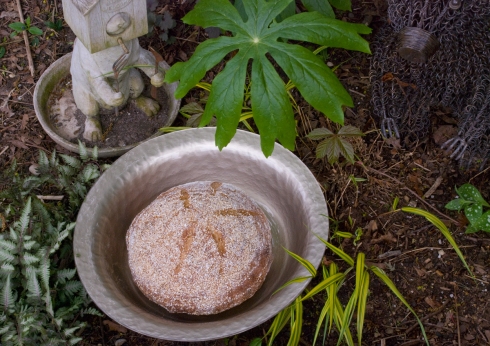They don't make sourdough bread like they used to — not even in San Francisco! The city used to be renowned for its sourdough bread as far back as the California gold rush of 1849. I call this recipe "sour bread" because it does not use a traditional sourdough culture; it would thus be misleading to call it "sourdough".
Through the years, San Francisco sourdough has been closely studied by microbiologists and food scientists. The microorganisms that produce the acids that give the bread its tangy flavor are well known.
The two main souring agents in San Francisco sourdough bread are acetic acid and lactic acid. This recipe is for a yeasted bread to which the baker adds acetic and lactic acids. The result is a sour bread which is very close in flavor to traditional San Francisco sourdough.
A loaf of traditional sourdough bread takes a long time to make due to the long proofing times required for the starter and the bread dough. Because this recipe uses baker's yeast, the proofing time is greatly reduced.
These directions are for one small loaf or boule. You can make a larger bâtard simply by doubling the ingredients.
Because acids are added directly to the dough, it is advisable to make this recipe using bread flour (not all-purpose flour) due to bread flour's higher gluten content.
WHAT YOU WILL NEED:
A digital scale White vinegar Liquid lactic acid
https://www.amazon.com/gp/product/B000MBW7V2/ref=ppx_yo_dt_b_search_asin_title?ie=UTF8&psc=1 An eyedropper Bread flour Water Salt Instant or "rapid rise" yeast A sharp blade An electric mixer is helpful but is not required. Some knowledge of artisan baking techniques is helpful.
IMPORTANT!!! Do not use "active dry" yeast. Make sure the yeast is "instant" or "rapid rise". If Fleischmann's yeast is used, look for the bright yellow packets.
It is important to measure the ingredients as precisely as possible. In addition to a digital scale, I use an eyedropper to measure the vinegar and whey.
Combine the following ingredients in a mixer bowl:
146 grams flour
92 grams water
(Optional) 1/2 teaspoon diastatic malt powder
Mix flour, water and malt powder to the "shaggy" stage. All of the flour should be wet. Let rest (autolyze) for 30 minutes.
Add the following ingredients:
3.5 g Instant dry yeast
1/2 teaspoon salt
1.5 g White vinegar
1.5 g liquid lactic acid
Mix until a dough ball forms.
Place the dough ball on a towel or preferably a flax linen cloth and allow to proof for 2 hours in a warm place.
Using a sharp knife or blade, cut some slits in the top crust, about 1/4 inch deep. These slits allow the crust to expand while baking.
Bake at 375° to 425° F for one hour. You can steam the oven prior to baking by placing a shallow pan of water in the oven as it heats up, or bake in a Dutch oven or roasting pan.
During baking, the slits you have cut into the crust will open up. This is an indication of oven spring, or the degree to which the yeast has raised the bread.
VERY IMPORTANT: It is important to let the loaf cool completely after baking. This will take some time, anywhere from one-half to one hour. The flavor is still developing as the bread cools, so for the best flavor it is important to allow the loaf to cool completely.
THE RECIPE IN BAKER'S PERCENTAGES
| Ingredient | Baker's percentage: | Grams boule: | Grams bâtard: |
| Flour | 100% | 146 | 292 |
| Water | 60% | 88 | 176 |
| Salt | 2% | 3 | 6 |
| Instant Yeast | 2.7% | 3.5 | 7 |
| Diastatic malt powder | | 1/2 tsp | 1/2 tsp |
| Lactic acid (liquid) | 1% | 1.5 | 3 |
| White Vinegar | 1% | 1.5 | 3 |
| Total Dough Weight | | 240 | 480 |
| Hydration | 60% | | |




































